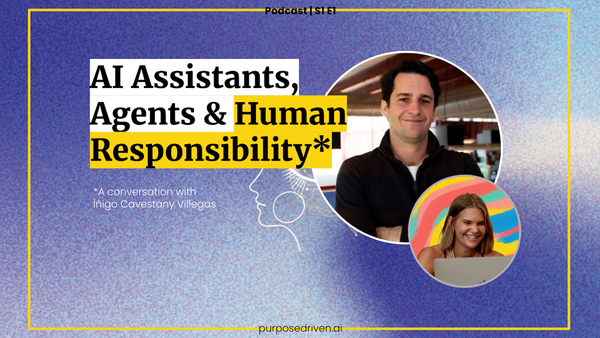By Maaria Tiensivu, Chipp Gold Partner and Co-Founder at Purpose Driven AI

This post is brought to you by Maaria Tiensivu, Chipp Gold Partner and founder of Purpose Driven AI.
What does it mean to build AI with purpose? In a recent conversation with IBM’s Íñigo Cavestany Villegasas, we explored the crucial differences between AI assistants and agents, the lessons learned from gaming, and the real-world responsibilities that come with building intelligent systems.
For those who want to dive deeper, you can watch the full conversation here:
👉 Watch the full YouTube video
Here are the key insights—and how you can put them into action today.
1. Know the Difference: AI Assistants vs. AI Agents
Insight:
AI assistants help you complete tasks, but AI agents can act on your behalf, make decisions, and even learn from their environment. This distinction is more than technical—it’s about trust, autonomy, and responsibility.
Put it into action:
- Before building, ask: “Do I need an assistant or an agent?”
- For simple, repeatable tasks, assistants are ideal. For workflows that require adaptation or decision-making, agents are the future.
- With no-code tools like Chipp.ai, you can experiment with both—start with a simple assistant, then evolve it into an agent as your needs grow.
2. Small is Powerful: The Rise of Specialized AI
Insight:
The future isn’t one giant AI that does everything. It’s a network of smaller, specialized models—each designed for a specific purpose.
Put it into action:
- Don’t try to build a “do-it-all” AI. Instead, focus on solving one problem really well.
- Use Chipp.ai’s modular approach to create multiple agents, each with a clear, narrow focus.
- Regularly review and refine your agents—specialization leads to better results and fewer surprises.
3. Learn from Gaming: Technology as a Force for Growth and Connection
Insight:
Íñigo’s journey from competitive gaming to AI leadership revealed that, when used intentionally, technology isn’t just about efficiency or automation—it can be a powerful catalyst for personal growth and deeper human connection.
Put it into action:
- Approach AI and technology as tools to bring people together, not just to optimize processes.
- Design your AI projects to foster collaboration, learning, and shared experiences—just as gaming communities do.
- Use platforms like Chipp.ai to build agents that support teamwork, mentorship, or community engagement, amplifying the human side of innovation.
4. Ethics by Design: Ask the Hard Questions Early
Insight:
Real-world AI mishaps often come from ignoring ethical questions until it’s too late. Responsible builders ask tough questions from the start.
Put it into action:
- Before launching, ask: “What could go wrong? Who could be harmed?” Use the answers as a guiding force to make your AI solutions better.
- Use Chipp.ai’s privacy and control features to safeguard user data and limit unintended consequences.
- Involve diverse voices in your design process—ethical AI is a team sport.
5. Human-AI Collaboration: The Future is Hybrid
Insight:
The best results come when humans and AI work together, each doing what they do best.
Put it into action:
- Design your agents to augment, not replace, human expertise.
- Use Chipp.ai to embed your own knowledge and documents, creating agents that truly understand your context.
- Keep humans in the loop for critical decisions—AI is a partner, not a replacement.
Final Thought: Build with Purpose, Lead with Action
Building AI isn’t just about technology—it’s about intention, responsibility, and impact. Whether you’re a business leader, developer, or simply curious, the path forward is clear: start small, ask the right questions, and build with purpose.
Ready to put these insights into action? Try building your first assistant or agent with Chipp.ai—no code required.
Want to watch the full conversation?
👉 Building AI with Purpose: AI Assistants, Agents & Human Responsibility (YouTube)

